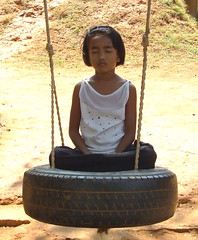…was Ayya Khema‘s noble intention. Let us all walk in her footsteps.
better i respond now, before letting this lie around too long…so short answers. if not clear enough, give me a call 🙂
I’m glad we talked about the Buddhanussati meditation, i tried it last night… it seems to be helpful… It is hard to find on the internet exactly how to do it, so i was using the instructions that you gave long time ago for the kammatthana, using ‘sattha’ or ‘sattha devamanussanam’. Is is the best way, or should i think about all the virtues…?
– should i recollect a virtue, then try to generate a feeling, or just contemplate the virtue only? I mean, should the goal be to have a ‘feeling’, like with metta meditation?
– if it is a feeling, should it be a feeling directed toward the buddha? I know you aren’t supposed to do metta for a dead person, so since it seems like if i was to generate a feeling towards the buddha (based on a virtue) in this case, it would be similar to metta, probably that’s not what i’m supposed to do… ?
– i was reading that Buddhanussati can only be used to get to ‘access concentration’, not to jhana, but still i’m thinking that this further indicates that it should be done as more of a contemplation rather than a generation of a feeling. Then that would explain why they say it would not lead to jhana due to its ‘complexity’.
hope this brings some light into the matter.
Question: When doing Samatha, if I get to the point of sustained attention using metta, should i shift my attention somewhere else at this point?check this: http://www.leighb.com/jhana3.htm
Again, i know we are not making a differentiation between access concentration and jhana like he is, but Leigh is just saying that access concentration is when you are able to sustain attention on the object, seems like he is meaning before piti/sukha…
Anyway, I was wondering what your opinion is on shifting attention … here he is talking about breath, but later he is saying to shift the attention like this for any object you are using… he means to shift it to any pleasant sensation in the body that you notice:If the breath gets very, very subtle, or if it disappears entirely, instead of taking a deep breath, shift your attention away from the breath to a pleasant sensation. This is the key thing. You watch the breath until you arrive at access concentration, and then you let go of the breath and shift your attention to a pleasant sensation. There is not much point in watching the breath that has gotten extremely subtle or has disappeared completely. There’s nothing left to watch. Shift your attention to a pleasant sensation, preferably a pleasant physical sensation.
You will need a good bit of concentration to watch a pleasant physical sensation, because a mildly pleasant feeling somewhere in your body is not nearly as exciting as the breath coming in and the breath going out. You’ve got this mildly pleasant sensation that’s just sitting there; you need to be well-concentrated to stay with it.
One reason i’m asking is because let’s say i’m using metta: i have the metta feeling, AND i have sustained attention on metta, but then what? i remember i already asked you before how to tell the difference between metta feeling (meditation object) and piti/sukha… and you said that the piti/sukha would be sustained without effort…. but it is still not clear, since it seems like the metta feeling is also sustained without effort.. at least to some extent, before piti arises, isn’t it? Then when i was reading Leigh’s instructions, i was wondering if i need to somehow shift the attention…???
Also, one more question, this is from Bhante G’s book, he is saying this should be done after reaching first jhana, but before going on to the second jhana:Perfecting the first jhana:The meditator should try to acquire five kinds of mastery over the jhana: mastery in adverting, in attaining, in resolving, in emerging and in reviewing.
– Mastery in adverting is the ability to advert to the jhana factors one by one after emerging from the jhana, wherever he wants, whenever he wants, and for as long as he wants.– Mastery in attaining is the ability to enter upon jhana quickly
– mastery in resolving the ability to remain in the jhana for exactly the pre-determined length of time,
– mastery in emerging the ability to emerge from jhana quickly without difficulty,
– mastery in reviewing the ability to review the jhana and its factors with retrospective knowledge immediately after adverting to them.Question: I think ‘advert’ means ‘directing attention to’, but not clear, what do you think he means in the part i highlighted above? What do you think about this, is it necessary?
That is a rather fancy translation of the pali for “paccavekkhana”.
Here is an entire posting on this topic:
http://theravadin.wordpress.com/2008/04/16/reflecting-on-the-jhana-factors/
 Jhanas are a better foundation of any Vipassana practice and they are less difficult than many people think. The more people know and practice right concentration the bigger the benefit for the Dhamma overall. Being less mysterious than most people imagine they are not less enjoyable and beneficial once you are able to attain them repetitively. One way of better understanding them is to imagine concentration as a process. Your mind will quite naturally pass through the four jhanas when you succeed in moving your attention inward holding and focusing it on a mental object. The rest will happen by itself. Have a look at the jhana factors to understand your progress and know the 5 hindrances to identify your weak spots. Good luck!
Jhanas are a better foundation of any Vipassana practice and they are less difficult than many people think. The more people know and practice right concentration the bigger the benefit for the Dhamma overall. Being less mysterious than most people imagine they are not less enjoyable and beneficial once you are able to attain them repetitively. One way of better understanding them is to imagine concentration as a process. Your mind will quite naturally pass through the four jhanas when you succeed in moving your attention inward holding and focusing it on a mental object. The rest will happen by itself. Have a look at the jhana factors to understand your progress and know the 5 hindrances to identify your weak spots. Good luck!




